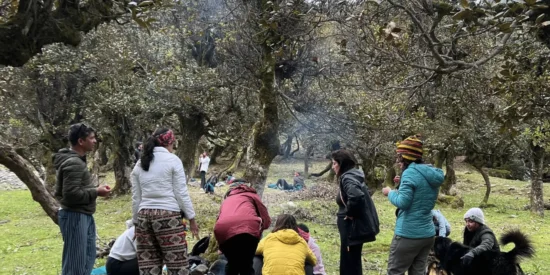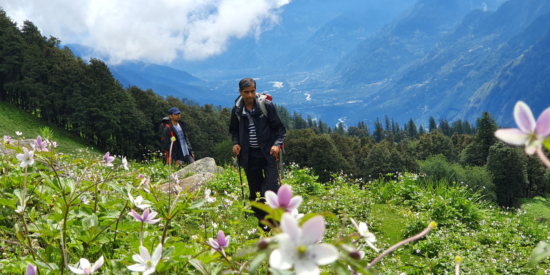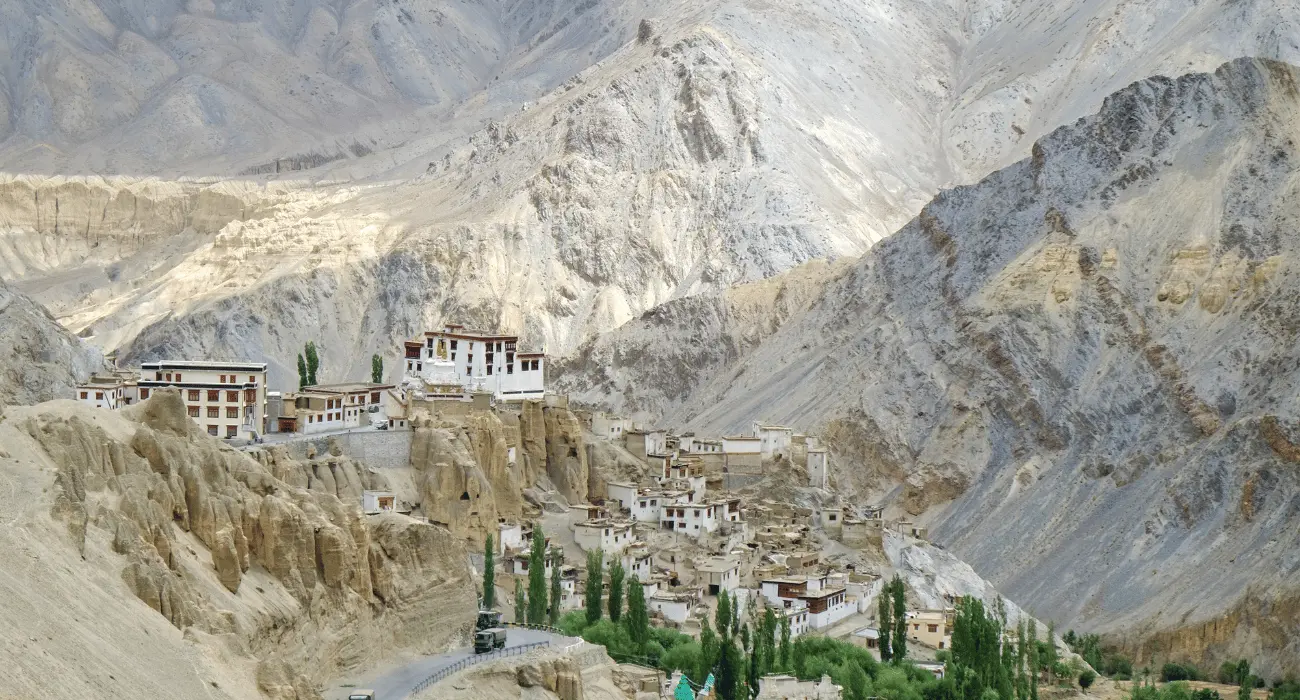- Embark on an adventurous bike trip through the mesmerizing landscapes of Ladakh.
- Reach high altitudes, with the maximum altitude varying depending on the specific route.
- Encounter diverse weather conditions, from scorching sun in the daytime to chilly nights.
- Experience a thrilling journey with moderate to challenging difficulty levels, navigating through rugged terrains and mountain passes.
₹185,000.00 + 5% GST
Not So Fast Ladakh: A Mindful Ladakh Motorcycle Tour From Manali (14 days)
Explore 'Remote' Ladakh on a mindful 14-day motorcycle tour from Manali with YoloO Life. Our focus is on riding on open roads, admiring the unique landscapes, connecting with nature, and savouring good food.
- High Altitude Passes including Khardung La, Tanglang La and Baralacha La
- Breathtaking ride on the Moore Plains, a high-altitude plateau
- Ride on the banks of Lakes, Pangong Tso and Tsomoriri Tso
- Find time for mindfulness and inner peace
- Comfortable accommodations in charming locations
- Expert Guide, Mechanic, Backup Vehicle and first aid to ensure a safe and unforgettable journey
Not So Fast Ladakh Motorcycle Group Tour:
Guaranteed Group Departures:
- 08th June 2025
- 06th July 2025
- 10th August 2025
- 14th September 2025
‘Not So Fast Ladakh’ Motorcycle Tour Cost: All Inclusive
- Solo Rider: INR. 185000 + 5% GST
- Rider with Pillion (2 people on 1 bike): 330000 + 5% GST
Set forth on an extraordinary odyssey, venturing through the mystical terrains of Ladakh on ‘Not So Fast Ladakh’ an epic bike trip designed by experts. Over 14 exhilarating days, you will venture through some of the highest mountain passes in the world including Chang La, Khardung La and Tanglang La, ride on the Changthang Plateau and the banks of mighty Lakes unraveling why this is regarded as on of the greatest road trips in the world. From the ancient monastic wonders of Thiksey and Hemis to the ethereal beauty of Pangong Tso, Tsomoriri and Nubra Valley, you will immerse yourself in the captivating grandeur of Ladakh’s iconic landmarks. With each rev of the engine on this ‘Not So Fast Ladakh Tour‘, you’ll forge unforgettable memories amidst the pristine landscapes and vibrant cultural tapestry of this high-altitude paradise. Prepare to be captivated as you embark on a journey of a lifetime, where adventure and beauty converge on the roads less traveled.
Not So Fast Ladakh Motorcycle Tour Highlights
The Route
Route: Manali – Rohtang Pass – Keylong – Baralacha La – Sarchu – Nakee La – Lachulung La – Pang – Leh – Khardung La – Nubra Valley – Diskit – Hundar – Panamik – Wari La – Pangong Tso – Leh – Thiksey Monastery – Shey Palace – Hemis Monastery – Tso Moriri – Chumathang – Jispa – Keylong – Rohtang Pass – Manali.
Short Itinerary of the 'Not So Fast Ladakh Motorcycle Tour'
Day 01: Arrival in Manali, bike allocation, test drive, and dinner in Old Manali.
Day 02: Challenging ride to Sarchu via Rohtang La and Lahaul Valley, overnight stay in tents.
Day 03: Ride from Sarchu to Leh over Baralacha La, Nakee La, Lachulung La, and Pang, and explore Leh in the evening.
Day 04: Rest day in Leh for vehicle checkup and sightseeing, visit Leh Palace, Shanti Stupa, and local markets.
Day 05: Ride to Nubra Valley via Khardung La, the highest motorable pass, visit Diskit Monastery and enjoy the sand dunes at Hundar.
Day 06: Drive to Panamik along the scenic Shyok River, and visit Hundar and Baigdandu, known for hot springs and beautiful landscapes.
Day 07: Ride to Pangong Tso via the adventurous Shyok River road, pass through Wari La, and enjoy the breathtaking views of the lake.
Day 08: Ride back to Leh, en route visit Thiksey Monastery, Shey Palace, and Hemis Monastery, evening at leisure.
Day 09: Leh
Day 10: Journey from Leh to Tso Moriri, a lesser-explored lake, admire the pristine beauty, and camp by the lakeside.
Day 11: Tsomoriri – Karzok – Kiangdom hike/ride
Day 12: Drive from Tso Moriri to Jispa, passing through Chumathang hot springs and scenic landscapes, and overnight stay in Jispa.
Day 13: Ride from Jispa to Manali via Keylong and Rohtang Pass, enjoy the thrilling descent and reach Manali by afternoon.
Day 14: End of Not So Fast Ladakh Tour. Departure from Manali by Volvo in the evening.
Detailed Itinerary of the 'Not So Fast Ladakh Adventure'
ITINERARY:
DAY 01: ARRIVAL IN MANALI – ALLOTMENT OF BIKES AND TEST DRIVE
Arrive in Manali, then our support staff will receive you at the bus stop and drive you to our base. After refreshments and debriefing and the required paperwork, bikes will be allocated to you. Get used to your bikes while we go for a drive to Old Manali for an early dinner. Ride back to the base for a good night’s sleep. Any last minute shopping can be done while in Manali.
DAY 02: MANALI – ROHTANG LA (3978 M) – DEEPAKTAAL – SURAJTAAL – BARALACHA LA (4890 M) – SARCHU – 228 KM – 8 HRS – CHALLENGING RIDE OVER ROHTANG PASS IN TRAFFIC AND MIST AND THEN SOME WICKED ROADS
We start our journey from Manali (at 09000 hrs) to Leh stopping at Sarchu for the first night. Today we cross Rohtang La (3978 m), (La means Pass). The Rohtang La is the gateway to Lahaul. The valley of Lahaul is situated to the south of Ladakh. For this very reason this place derived its name “Lho-Yul” meaning “Southern Country”.
Lahaul abounds with monasteries or gomphas, the homes of Lamas (Buddhist monks); therefore Lahaul is often referred to as “The Land of the Lamas”. The mountains rise to a mean elevation of 18000 feet, with the highest peak touching over 21000 feet and the lowest touching 9000 feet where River Chenab enters Chamba. Numerous lateral spurs shoot off from the main mountains filling all the valleys with glaciers. It is this feature which made Andrew Wilson, a European traveler (1873), call Lahaul “a valley of glaciers”.
The whole Lahaul & Spiti district is a cold desert whose bare rocks and steep slopes stare the visitors in the face. The Rivers Chandra & Bhaga, which constitute the River Chandrabhaga/Chenab after their confluence at Tandi, are the major features of the geomorphology of this region.
Tandi: The village is situated above the confluence of the rivers Chandra and Bhaga in the Pattan Valley some 7 kms away from Keylong. Revenue and settlement records reveal that Tandi was founded by Raja Rana Chand Ram under the name of Chandi which over the years got corrupted into Tandi.
There are at least three mythological stories connected with Tandi. First, Tandi is believed to mean Tan Dehi, i.e., giving up the body. This is associated with Draupadi, the wife of Pandavas, who left her body at this place. Second, this is believed that Rishi Vashishtha, who meditated near the hot water springs of Manali, was cremated at this confluence; hence named Tandi, i.e., body consumed. According to the third, Chandra and Bhaga were son and daughter of the Moon and the Sun Gods respectively. They were in love with each other. To perform their celestial marriage they decided to climb the Baralacha-La and from there run in opposite directions encircling a vast tract of Lahaul. Thus flowing south-east and south-west both met at Tandi to enter the wedlock. At Tandi top up our fuel tanks.
Keylong: Keylong is the last place where your mobile phone will work before you reach Leh and also the last place where you can hope to find a mechanic, in case you are having some problems with your vehicle get it checked ASAP!
JISPA: This beautiful spot is 22 kms away from Keylong and 4 kms ahead of Ghemur. From Keylong roads are in somewhat better condition and only get smoother as you approach Jispa and eventually Darcha. Once at Darcha, take a break and tank up on supplies and get yourself registered at the check post in Darcha. The village is situated at the junction of two nullahs with the main river Bhaga. Jispa has a very large dry river-bed, a rarity in Lahaul. Good Juniper plantation is around this village.
Stay: Swiss Tents on twin sharing
Meals: Breakfast, Lunch and Dinner
DAY 03: SARCHU TO LEH OVER BARALACHA LA (4890 M), NAKEE LA (4769 m), LUNGLACHA LA (5059 M) – TAGLANG LA (5328 M) – LEH – 154 KM – 8 HRS – CHALLENGING 70KM TO PANG THEN SOME MIND-BLOWING RIDING ON THE MOORE PLAINS ON AWESOME ROADS AFTER PANG
Today we cross Baralacha La (4890 m), before Baralacha La we will stop briefly for a photography session at Lake Deeptaal and the magnificent Lake Surajtaal. Roads are mostly in bad shape and as the altitude increases, you might start noticing the first effects of Acute Mountain Sickness. It is advisable to take it easy and don’t over stress yourself, especially at the summit of Baralacha La, 16,500ft. From Baralacha La it is again a downhill but a rough ride till Bharatpur, after which the road condition starts improving gradually as you approach Sarchu. Sarchu, at an altitude of 14,000ft, is a collection of tents and a military base. Even though it is quite a windy place and high in altitude, it is the prefered night stop for most travelers. You will need to register at the check post in Sarchu before proceeding further. Roads from Sarchu till the start of Gata Loops are not too bad. Gata Loops are a collection of 21 hair-pin bends that take you to an altitude of 15,302 feet, roads in the loops are in not so good condition and the slow moving trucks leaving clouds of thick smoke make the ascent feel tougher than it actually is. Next up is the third pass on the Manali Leh route, Nakee La, (4750 m or 15,547 ft. A few km up the road is Lachulung La, (5059 m or 16,616 ft.)
The descent from Lachulung La will take you to Pang which is a temporary tent settlement and has a check post where travelers need to register themselves.
The road from Pang to Leh is excellent and will take you over a plateau (42 km long), Skyangchu Thang (The biggest and highest plateau on earth), also called the Moore Plains.
Stay: 3 star hotel – Hotel Auspicious or like on twin sharing
Meals: Breakfast, Lunch and Dinner
DAY 04: LEH – REST DAY AND SPECTACULAR SHOOTING OF NOT TO MISS PLACES IN AND AROUND LEH – OPTION OF RAFTING — ROADS MAINTAINED BY BRO IN EXCELLENT CONDITION
Day for some rest and checkup of the vehicles and then some sightseeing
Come early afternoon, we’ll drive to the 17th-century Leh Fort, the most famous landmark in town. From the Fort there’s a short trail up to Tsemo Palace; the light walking can help you acclimatize, but we’ll gladly whisk you to the top by car if you prefer. At the top is a big reward: sweeping 360° views of Leh, the valley and its surrounding mountains, which includes the well-known 6000m+ Stok Kangri peak, towering in the distance at a height of 6,137m.We head to Leh’s other great panorama point, the Shanti Stupa, late in the afternoon. The view from here is quite different to the one from Leh Palace: you get a sense of the huge mountain spaces, and the illuminated town in the late ‘blue’ evening light makes for compelling images. Especially in the night when the Stupa is lit, the view is spectacular.
Thiksey, 40mins drive from Leh (especially in the right light) is simply spectacular. Tier upon tier of buildings rise on a crag above the River Indus, white fronts bouncing the prevailing light back at you against the deep Ladakh sky. We wander next through the monastery complex, the photo opportunities coming thick and fast. (You know those iconic National Geographic-style Tibetan/Ladakhi/Buddhist shots that got you all fired up about coming here in the first place? —they probably came right out of this same monastery.)
We tear ourselves away to go a few minutes north to Shey, a palace and a monastery that also tumbles splendidly down a hillock. Once the home of royalty — the Namgyal kings were required to father their sons here — it now houses the largest metal statue of Buddha in Ladakh. It is 7.5m high, built from Zanskar copper hammered out into sheets on a nearby rock and gilded with five kilograms of solid gold. Hemis Gompa: the largest monastic foundation of Drukpa Kagyu Order of Tibetan Buddhism and Stok Palace & Sindhu Ghat. Overnight stay in Leh.
Stay: 3 star hotel – Hotel Auspicious or like on twin sharing
Meals: Breakfast, Lunch and Dinner
DAY 05: LEH – KHARDUNG LA – NUBRA (DISKIT – HUNDAR) – TURTUK (BALTISTAN) – 205KM – 7 HRS – EASY RIDING OVER MOSTLY GOOD ROADS THANKS TO BRO (BORDER ROADS ORGANISATION)
Turtuk is a village 205 km from Leh on the banks of Shyok River. Turtuk gram panchayat is the northernmost village of India. Turtuk was under Pakistan’s Control till 1971, but later India got control of this strategic area. Predominantly a Muslim village, residents speak Baltistani, Urdu and Ladakhi Language. Turtuk, is the last outpost in India from where the Pakistan- controlled Northern Areas begin. Turtuk is one of the gateways to the Siachen Glacier. Diskit Monastery also known as Deskit Gompa or Diskit Gompa is the oldest and largest Buddhist monastery (gompha) in the Nubra Valley of Ladakh, northern India. It belongs to the Gelugpa (Yellow Hat) sect of Tibetan Buddhism. It was founded by Changzem Tserab Zangpo, a disciple of Tsong Khapa, founder of Gelugpa, in the 14th century. It is a sub-gompa of the Thiksey gompha. Lachung Temple and Hundar Monastery are also located nearby; the latter is below the main road near a bridge. The monastery has a statue of Maitreya Buddha in the prayer hall, a huge drum and several images of fierce guardian deities. An elevated cupola of the monastery depicts a fresco of the Tashilhunpo Monastery of Tibet. The village of Turtuk which was unseen by tourists till 2010 is a virgin destination for people who seek peace and an interaction with a tribal community of Ladakh. The village is stuffed with apricot trees and children. The local tribe, Balti, follow its age old customs in their lifestyle and speak a language which is just spoken and not written. For tourists Turtuk offers serene camping sites with environment friendly infrastructure. Enjoy the scenic drive. Stay in homestay/camp.
Stay: Swiss Tents/Homestay on twin sharing
Meals: Breakfast, Lunch and Dinner
DAY 06: TURTUK – HUNDER – DISKIT – WARSHI – PANAMIK – 145 KM – 5 HRS – A BEAUTIFUL RIDE ALONG RIVER SHYOK ON GOOD ENOUGH ROADS
Today we will drive 105 km to Warshi and then a U-turn to the other bank of River Shyok to Panamik. Nubra is a tri-armed valley located to the north east of Ladakh valley. Diskit the capital of Nubra is about 150 km north from Leh town, the capital of Ladakh district, India. Local scholars say that its original name was Ldumra (the valley of flowers). The Shyok River meets the Nubra or Siachan River to form a large valley that separates the Ladakh and Karakoram Ranges. The Shyok river is a tributary of the Indus river. The average altitude of the valley is about 10,000 ft. i.e. 3048 m above the sea level. The common way to access this valley is to travel over the Khardung La pass from Leh town. On the Shyok (pronounced Shayok) River, the main village, Diskit, is home to the dramatically positioned Diskit Monastery which was built in 1420 AD. Hundar was the capital of the erstwhile Nubra kingdom in the 17th century, and is home to the Chamba Gompa. Between Hundar and Diskit lie several kilometres of sand dunes, and (two-humped) bactrian camels graze in the neighboring “forests” of seabuckthorn. Non-locals are not allowed below Hundar village into the Balti area, as it is a border area. The beautiful village of Baigdandu is also located in this area. There is a marked presence of people with startling blue eyes, auburn hair and rosy cheeks as against the typical mongoloid features of the Ladakhis. Local lore has it that they were a Greek tribe who came in search of Jesus Christ’s tomb and eventually settled here. Baigdandu is also known for the goats that give you the famous Pashmina shawls. Drive along the banks of the Shyok river, where a bit of patience, a touch of luck and a long telephoto might capture you red fox, partridge, hare, weasel and migratory ducks resting in river pools. There is much to pleasurably distract us here: if the light is good you’ll be asking to stop every mile or so to capture an amazing atmospheric river valley landscape, a field of shockingly vivid lavender or yellow barley.
Stay: Swiss Tents on twin sharing
Meals: Breakfast, Lunch and Dinner
DAY 07: PANAMIK – SHYOK – DURBUK – TANGSTE – LUKUNG – SPANGMIK (PANGONG TSO) –187 KM–8 HRS – EASY RIDING MIXED WITH REALLY DEMANDING BITS ON SHYOK RIVER ROAD AND IF THIS ROAD IS CLOSED, THEN THE ALTERNATE ROUTE IS A CHALLENGING RIDE OVER WARI LA
Pangong Tso: Tibetan for “long, narrow, enchanted lake”, also referred to as Pangong Tso, is an endorheic lake in the Himalayas situated at a height of about 4,350 m (14,270 ft). It is 134 km long and extends from India to Tibet. Approximately 60% of the length of the lake lies in Tibet. The lake is 5 km (3.1 mi) wide at its broadest point. All together it covers 604 km. During winter the lake freezes completely, despite being saline water. It is not part of Indus river basin area and geographically a separate landlocked river basin. The brackish water of the lake has very low micro-vegetation. Guides report that there are no fish or other aquatic life in the lake, except for some small crustaceans. On the other hand, visitors see numerous ducks and gulls over and on the lake surface. There are some species of scrub and perennial herbs that grow in the marshes around the lake. The lake acts as an important breeding ground for a variety of birds including a number of migratory birds. During summer, the Bar-headed goose and Brahmini ducks are commonly seen here. The region around the lake supports a number of species of wildlife including the kiang and the Marmot. Formerly, Pangong Tso had an outlet to Shyok River, a tributary of Indus River, but it was closed off due to natural damming. Two streams feed the lake from the Indian side, forming marshes and wetlands at the edges. Strand lines above current lake level reveal a 5 m (16 ft.) thick layer of mud and laminated sand, suggesting the lake has shrunken recently in geological scale.
Camp at an awesome location by the lake.
Stay: Swiss Tents on twin sharing
Meals: Breakfast, Lunch and Dinner
Day 8: Pangong Tso – Leh | 160 Km | 4-5 hours
After a hearty breakfast, as we leave behind the emerald blue waters of Pangong to ride over the 3rd highest motorable pass, Chang La at 5360 meters. It would be a slightly relaxed ride today. Once over Chang La, most of the ride is downhill. This is going to be one exciting ride that you’ll remember forever.
Stay: Nice Homestay/Guesthouse on triple sharing
Meals: Breakfast and Dinner
Day 9: Leh – Explore Leh
Day 10: Leh – Tso Moriri | 210 Km | 7-8 hours
Start from Leh in the morning on bikes – Located at an altitude of 15,075 ft, Tso Moriri is the largest of the high altitude lakes in the Trans-Himalayan biogeographic region – Tso Moriri is a hidden gem in the region and not very touristy yet – Enjoy the view from deluxe tents – Overnight stay at Tso Moriri.
Stay: Nice Homestay or Private Camping on triple sharing
Meals: Breakfast and Dinner
Day 11: Tso Moriri – Hike/Ride to Kiangdom – Explore Karzok village – Meet The Locals – some time to reflect and introspect today
Day 12: Tso Moriri – Tsokar Tso – Sarchu | 220 Km | 8-9 hours
After breakfast, start your ride to Sarchu via another beautiful Lake and village of Tsokar. Reach Sarchu by evening and check-in to your camps. Overnight stay at Sarchu.
Stay: Camping or tented accomodation provided by the locals
Meals: Breakfast and Dinner
Day 13: Sarchu to Manali | 225 KMS | 8-9 hours
Morning leave for Manali – On the way visit Suraj Taal and Deepak Taal, two breath-taking lakes in the Lahaul region – Reach Manali by evening.
Stay: Comfortable rooms at ‘dA Base’ on triple sharing
Meals: Refreshments, Breakfast and Dinner
Day 14: Departure – Option of Paragliding, Zip-lining or Angling
After a leisurely breakfast participants can choose to explore Manali or go for paragliding or try the highest zip-line in the country. Those who just want to relax after the long exciting trip can choose to spend the day by the river and try angling (chose from add-ons)
Meals: Breakfast
Inclusions
- 13 Nights in 3 star Deluxe hotels and Swiss camps
- Stay on twin-sharing in private rooms
- Royal Enfield 500 cc/Himalayan at extra cost – choose add-on while booking)
- Petrol for the entire trip
- Breakfast, Lunch & dinner from dinner on day 1 to breakfast on day 14
- Service of an expert road captain throughout the bike ride
- Entry Fes to Monasteries, Mueseums etc on the itinerary
- Inner Line Permits (ILP) & Wildlife fees for restricted areas in Ladakh
- Backup vehicle (high clearance 4×4 vehicle)
- Mechanic for the entire tour carrying basic spares
- Basic First Aid Kit, medicines and oxygen cylinders
Exclusions
- Camera fees to Museums or Monasteries
- Meals at roadside restaurants/’Dhabhas’)
- Expenses of personal nature like tips, mineral water, beverages etc.
- Although we will provide helmets, for hygiene and comfort factors, riders and pillions are suggested to get their helmets
- Any item, activity or facility other than clearly mentioned within the inclusions & itinerary above
- Any spare parts of any kind, bike repair or maintenance etc. during
- Any activity fees, porter charges or any other expenses incurred by the participants during the sightseeing trips, other than as clearly mentioned within the sightseeing in inclusions and itinerary
- Any extra costs incurred due to extension/ change of the itinerary due to natural calamities, roadblocks, vehicle breakdown etc. factors beyond our control
- Rs. 20,000/- refundable amount to be paid as security deposit per bike at the time of bike allocation
- GST @5%
Things to Note for this 'Not So Fast Ladakh Motorcycle Tour'
- Driving License is mandatory for the rider. We advise our guest to carry their ID proof along during the tour
- Please cover yourself with insurance. We or any of our service providers would not be liable in case of any mishap/ loss etc.
- At the start of the tour, you have to deposit refundable security/ damage deposit of Rs 20,000/- per bike at our office in Manali (By cash/cheque)
- If there are any additional expenses due to bad weather or any other reason beyond the control of the operator on account of hotel stay, transportation, and meals etc. extra bills may be raised. which will be paid to the trip leader directly
- Damage to bike/helmet during the tour would have to be paid by the participant
- Participants will have to get their riding gear like gloves, knee/elbow pads etc.
- We have the right to change the itinerary during the time of tour as per current situation like a strike, natural disaster, local union regulations.
- If any group member wants to leave group in-between the tour then he/she has to pay the cost for transportation of bike from point of leaving the tour till Manali (Transfer cost Rs. 15000)
- For any minor or big damage to the motorbike, we do not claim from the insurance company. It is guest’s responsibility to whom we have allotted the bike to give the full amount of damage to the motorbike
- Carry small daypack bags to carry all expensive things with you. All participants are responsible for the safety and security of their belongings.
Know Before You Go on this Not So Fast Ladakh Motorcycle tour with YoloO Life
- Failing to report at the reporting time of 3 hours will be considered as a “No-show” case.
- The trip can be customized for 1 person. In fixed departures in group size, we take max. 15 bikes and a minimum of 8 bikes. However, if the group size is not met, no backup vehicle will be provided. If the backup vehicle is requested, the cost will be borne and shared by the participants.
- If there is a confirmed change in the trip plan, we will inform you well in advance.
- Participants are expected to have a reasonably good fitness level.
- In the trip, if the group size is not met, the trip will not be canceled
- Trekking and travel in the Himalaya not necessarily would always run exactly as scheduled. Allow for unplanned long days or early camps due to weather disruptions or similar causes.
- All participants are recommended to have travel insurance that covers trekking and wilderness travel.
- Wear shoes and clothes you are comfortable in and do not forget waterproof jackets and warm clothing.
- Do not litter the environment. Polythene and plastics are non-biodegradable and unhealthy for the environment and must not be littered or burned and should be carried back
- Soak up the atmosphere – close your eyes and take in the sights and sounds as you explore and observe.
Items to Carry on this 'Not So Fast Ladakh Motorcycle Tour'
Clothing and Footwear
Lowers for riding
- Riding Boots
- Pants: 3 – 4 pair recommended – The quick dry and lightweight synthetic pants. Alternatively track pants are also comfortable to rest in. Jeans and denim are not recommended except on rest days.
- Cotton T-shirts: 4 – 5 – preferably full sleeves
- Sweatshirts – 3 – 4
- Synthetic Fleece Jacket: 1
- Windproof/Waterproof Jacket: 1
- Down Jacket/Hollow fiber fill/Insulated Jacket – 1 (optional – get this if you want to stay extra warm at camps)
- Thermal liners – 1 pair upper and lower (recommended)
- Good Riding shoes
Miscellaneous
- Torch
- Whistle
- Trekking Pole (optional)
- Sunglasses and Sun Cap
- Sunscreen and Chapstick
- Comfortable hiking shoes (waterproof)
- Water bottle
- Any personal medication
Note: We advise you to carry all the belongings in a rucksack.
How to reach Manali for the 'Not So Fast Ladakh Motorcyle Tour'
- Delhi to Manali – Volvo Bus
- Chandigarh to Manali – Volvo Bus
- Delhi to Bhuntar – Flight (we’ll arrange for a pickup at the airport on request)
*If you need any assistance with your travel bookings, let us know and we’ll be happy to help!
Safety@Yoloo.Life
Safety & Adventure Sports
The most basic yet prominent principle of indulging in any adventure activity is to take all the necessary precautions for safety.
We at Yoloo.Life, keep it all in account and ensure maximum safety measures to pre-plan the trip and minimize any kind of risk. We plan to mitigate the risk of high altitude-related problems by preparing and acclimatizing well and staying in comfort.
We strongly suggest you keep yourself adequately hydrated- possibly double your water intake.
- Ensure that you take all your medications along to avoid any health issues.
- Inform your friends and family before you depart for the trip and let them know that this will be a ‘No-Network’ zone.
We will be your point of contact throughout the entire trip. Our complete staff is trained and certified, including our wilderness first responders on the programs. So in any case, we will be there to help you out.
'Not So Fast Ladakh Motorcycle Tour': Payments, Confirmation, and Cancellation Policies
Payment Policy
- You can book the tour with 20% advance at the time of booking
- Full payment is to be made up to 30 days in advance. We take a maximum of 12 participants per group. Group Tours are planned on a first come – first served basis.
- We can also send you the payment link and details over email.
Confirmation Policy
- Once the payment is received, you will be notified over email with a confirmation.
Cancellation Policy
- In the event of cancellation, we must be notified in writing (e-mail).
- Cancellation charges will be effective from the date we receive advice in writing, and cancellation charges would be as follows: –
Cancellation prior to 30 days from the trip
- Full refund minus the bank charges within 15 working days
Cancellation 15 to 29 days from the trip
- 50% refund within 15 working days
Cancellation up to 14 days from the trip
- No refund





